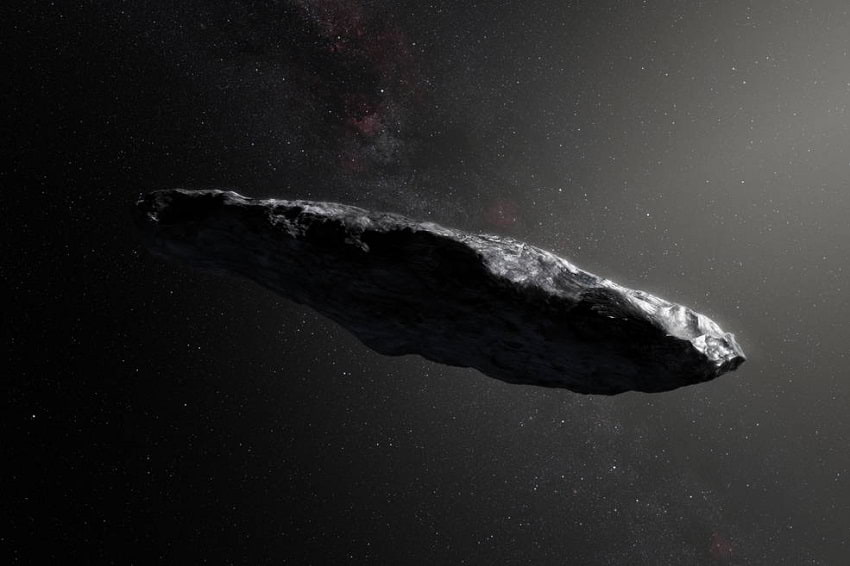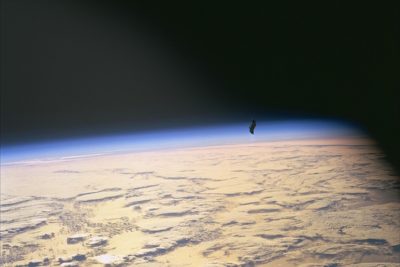ʻOumuamua: A Mysterious Interstellar Rock Discovered in Our Solar System
Share

An artistic impression of ‘Oumuamua. (European Southern Observatory / M. Kornmesser)
A mystery rock was spotted in our solar system on October 2017, which ended up sparking a lot of questions amongst the scientific community all over the world. This rock has been given the name ʻOumuamua – a Hawaiian word that basically stands for “scout or messenger from the distant past”. Prior to the detection of ʻOumuamua, we were unaware of the presence of any such interstellar objects present in our solar system.
The only feature that marked the rock as something that might belong to our solar system itself, was its composition of minerals and a characteristic reddish hue. Apart from these qualities, it appeared to be a space rock unlike anything ever spotted before. Shaped like a cigar, ʻOumuamua is nearly 400 meters in length. Not only that, the peculiar nature of the rock also includes the characteristic way it moves- spinning its way through space. Researchers say that it may be a ‘planetesimal fragment’, in the sense that during the formation of a planet in another solar system, it got ejected into space as a result of several factors which may include gravity and explosion of gases.
Discovery of the mystery rock
Observed from the Pan-STARRS1 telescope at the University of Hawaii, funded by NASA’s Near-Earth Object Observations program (NEOO), the ʻOumuamua was initially categorized as a comet. Later on, scientists decided it may be an asteroid due to the unusual activity exhibited by the space rock. Prior to this, interstellar objects were just a theory put forward by scientists. The arrival of the ʻOumuamua confirmed these theories that had plagued scientists for years. Observations made by researchers conclude that it is likely that the space rock has traversed its way through space for millions of years before finally entering our Solar System.
After the momentous discovery of the ʻOumuamua was made at the University of Hawaii, several telescopes were used to continue studying the interstellar object further. These included the European Organisation for Astronomical Research’s (ESO’s) Very Large Telescope (VLT) in Chile to measure its brightness, orbit and color. Space telescopes like the Hubble and Spitzer tracked the movement and speed of the interstellar object. The speed of the ʻOumuamua was marked as 98,400 mph (158,360 km/h) relative to the sun.
Peculiar characteristic traits of ʻOumuamua
With the help of images combined with ESO’s telescope and FORS instrument, a team of researchers, led by Karen Meech of Institute of Astronomy in Hawaii, discovered that the brightness factor of the space rock varies by 10 every 7.3 hours as it spins on its axis. This variation is a characteristic of the ʻOumuamua as a result of its peculiar size. The ratio of its length to width varies by a factor of 10 as well. The length to width ratio of typical space rocks tends to vary by 1:3. There is no evidence of any water or ice present on the surface of the rock, no dust present inside or around it, and it is a completely inert object right to its core.

ʻOumuamua’s changing brightness as it rotates. It appears the brightest when its full length is facing towards the Earth. (NASA / JPL-Caltech)
There are four classifications for a space rock with respect to its eccentricity. They could be circular, elliptical, parabolic, or hyperbolic. The ʻOumuamua happens to have a hyperbolic eccentricity. It was observed that most rocks having hyperbolic eccentricities have values greater than 1- typically around 1.0001. Astonishingly, the ʻOumuamua had a measured eccentricity of 1.2.
ʻOumuamua: An alien probe?
The space rock exhibited, interestingly, added acceleration as it reached deeper into our Solar System. Due to this occurrence, the ʻOumuamua was almost classified as an alien probe, being controlled by organisms that were from beyond our known world. However, data indicated that there was no such possibility, since there was no sign of activity on the rock itself. Also, owing to the sheer speed by which it travelled through space, it would be nearly impossible for any organism to exist on it. There was still speculation amongst certain scientific and extra-terrestrial enthusiasts’ fraternities as the extremities an alien organism may survive our beyond what we have been able to ascertain as definite.
The mystery behind the ʻOumuamua’s change in trajectory
Slight deviations noticed in the path of the space rock are not just an effect of gravitational forces, but could also be due to loss in mass. The thrust could have occurred due to the heating up of the surface, which would eventually lead to the formation of a comet tail comprised of several gases. As this did not actually occur, it ended up puzzling scientists till they realized that the Oumuaumua was actually inert in nature. Not only that, there are several other factors, including the rotation period, that come into play.
In the case of loss in mass and formation of a cometary tail, the rotation period around its axis would have varied. Fragmentation of the rock would have caused an abrupt kick in speed, but that did not happen either. Authors Shmuel Bialy and Abraham Loeb suggest that the change in trajectory could be due to solar radiation pressure.
Study of space rocks
Further study of the interstellar rock was declared impossible, due to the lack of adequate technology. No rockets made by humans would be able to catch up with the Oumuaumua. The gravitational net between Jupiter and the Sun hold the possibility to trap interstellar objects entering our Solar System in the future, but this is just a theoretical speculation at the moment.
ʻOumuamua 2.0
Looking forward, the Large Synoptic Survey Telescope will be operational by 2020-2022, and make the study of space rocks much easier.
On August 30th, 2019, Gennady Borisov detected another interstellar object that appeared to be something we might call the ʻOumuamua 2.0. As observed by NASA’s Scout system, it appears to have an unusual orbit, and measurements taken by compiling data provided by the Canada-France-Hawaii Telescope classify the object as an interstellar space rock. Its closest approach would be in the month of December.
Assumptions have been made regarding the trajectory and traits of this rock, and it is under constant observation. Whether a cometary tail will appear, or not, in the course of its path is the question. Bumps in speed have also been kept a look-out for, to confirm the interstellar nature of the rock. If there is no out-gassing, no tail, and no explanation regarding its origin, the nature of the ʻOumuamua 2.0 will be confirmed, and will aid in our study of the increasingly frequent detections of interstellar objects.
Enjoyed this article? You would also love “Truth Behind The Black Knight Satellite Conspiracy Theory“.
Fact Analysis:
STSTW Media strives to deliver accurate information through careful research. However, things can go wrong. If you find the above article inaccurate or biased, please let us know at [email protected]













